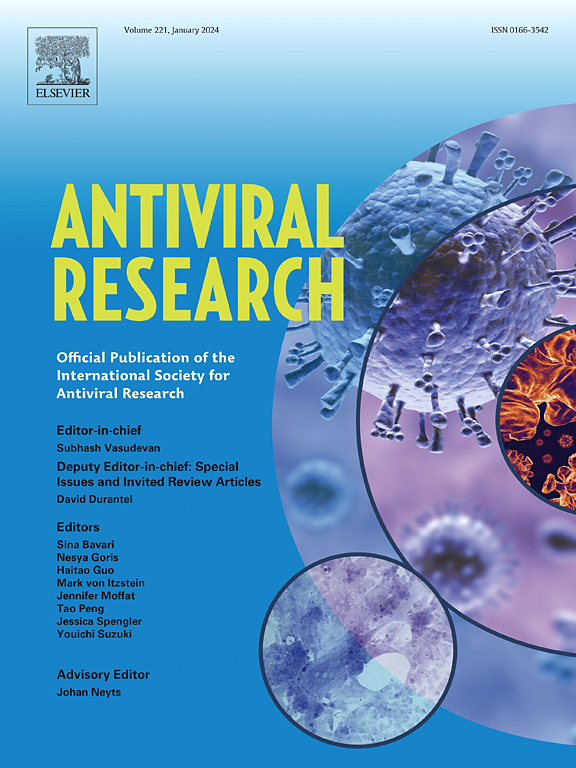Chemical arsenal for helicase Hunters: Striking the toughest targets in antiviral research
IF 4.5
2区 医学
Q1 PHARMACOLOGY & PHARMACY
引用次数: 0
Abstract
Helicases have emerged as promising targets in antiviral drug development but remain largely undrugged. To support the focused development of viral helicase inhibitors we identified, collected, and integrated all chemogenomics data for all helicases annotated in the ChEMBL database. After thoroughly curating and enriching the data with accurate annotations we have created a derivative database of helicase inhibitors which we dubbed Heli-SMACC (Helicase-targeting SMAll Molecule Compound Collection). Heli-SMACC contains 13,597 molecules, 29 proteins, and 20,431 bioactivity entries for viral, human, and bacterial helicases. We selected 30 compounds with promising viral helicase activity and tested them in a SARS-CoV-2 NSP13 ATPase assay. Twelve compounds demonstrated ATPase inhibition and a consistent dose-response curve. While Heli-SMACC provides a rich resource for identifying candidate inhibitors, cross-species compound transferability remains a significant challenge. In particular, inhibitory activity observed against viral helicases often does not translate well to human or bacterial homologs and vice versa due to differences in binding site composition, helicase structure, and cofactor dependencies. Despite these limitations, Heli-SMACC offers a valuable starting point for structure-based optimization and target-specific inhibitor design. The Heli-SMACC database may serve as a reference for virologists and medicinal chemists working on the development of novel helicase inhibitors. Heli-SMACC is publicly available at https://smacc.mml.unc.edu.

解旋酶猎人的化学武器库:打击抗病毒研究中最棘手的目标
解旋酶已成为抗病毒药物开发中有希望的目标,但在很大程度上仍未得到开发。为了支持病毒解旋酶抑制剂的重点开发,我们鉴定、收集并整合了ChEMBL数据库中注释的所有解旋酶的所有化学基因组学数据。经过彻底整理和丰富的数据与准确的注释,我们已经创建了一个衍生数据库的解旋酶抑制剂,我们称之为Heli-SMACC(解旋酶靶向小分子化合物收集)。Heli-SMACC包含13,597个分子,29个蛋白质和20,431个病毒,人类和细菌解旋酶的生物活性条目。我们选择了30种有希望的病毒解旋酶活性的化合物,并在SARS-CoV-2 NSP13 atp酶试验中对它们进行了测试。12种化合物表现出atp酶的抑制作用和一致的剂量-反应曲线。虽然Heli-SMACC为鉴定候选抑制剂提供了丰富的资源,但跨物种化合物的可转移性仍然是一个重大挑战。特别是,由于结合位点组成、解旋酶结构和辅因子依赖性的差异,对病毒解旋酶的抑制活性通常不能很好地转化为人类或细菌的同源物,反之亦然。尽管存在这些限制,但Heli-SMACC为基于结构的优化和靶向抑制剂设计提供了一个有价值的起点。Heli-SMACC数据库可为致力于开发新型解旋酶抑制剂的病毒学家和药物化学家提供参考。Heli-SMACC可在https://smacc.mml.unc.edu公开获取。
本文章由计算机程序翻译,如有差异,请以英文原文为准。
求助全文
约1分钟内获得全文
求助全文
来源期刊

Antiviral research
医学-病毒学
CiteScore
17.10
自引率
3.90%
发文量
157
审稿时长
34 days
期刊介绍:
Antiviral Research is a journal that focuses on various aspects of controlling viral infections in both humans and animals. It is a platform for publishing research reports, short communications, review articles, and commentaries. The journal covers a wide range of topics including antiviral drugs, antibodies, and host-response modifiers. These topics encompass their synthesis, in vitro and in vivo testing, as well as mechanisms of action. Additionally, the journal also publishes studies on the development of new or improved vaccines against viral infections in humans. It delves into assessing the safety of drugs and vaccines, tracking the evolution of drug or vaccine-resistant viruses, and developing effective countermeasures. Another area of interest includes the identification and validation of new drug targets. The journal further explores laboratory animal models of viral diseases, investigates the pathogenesis of viral diseases, and examines the mechanisms by which viruses avoid host immune responses.
 求助内容:
求助内容: 应助结果提醒方式:
应助结果提醒方式:


